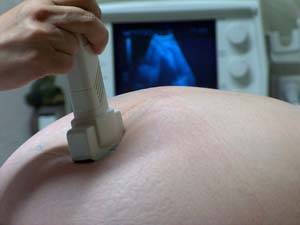Diagnostic Ultrasound
When and Why?
The Diagnostic Ultrasound in Pregnancy
– Why & When is it Used?
5. Placental localization.
Ultrasonography has grown to be indispensable in localizing the site of the placenta and establishing its lower edges, thus diagnosing or excluding placenta previa.
It is also possible to evaluate other placental abnormalities in conditions such as diabetes, fetal hydrops, Rh isoimmunization and severe intrauterine growth retardation.

6. Multiple pregnancies and diagnostic ultrasound.
In this situation, ultrasonography is of great importance in determining the number of fetuses, the chorionicity, fetal presentations, evidence of growth retardation and fetal anomaly, the presence of placenta previa, and any suggestion of twin-to-twin transfusion. 4D ultrasound can also be used successfully.
7. Hydramnios and Oligohydramnios.
Large or dwindling amounts of liquor or amniotic fluid can be shown by ultrasound. Both conditions can cause adverse effects on the fetus.
In both these situations, careful 3d ultrasound examination should be undertaken in order to exclude intraulterine growth retardation and congenital malformation in the fetus such as intestinal atresia, hydrops fetalis or renal dysplasia.
Other Areas for Diagnostic Ultrasound
Ultrasonography is also invaluable in other obstetric conditions such as:
a) verification of intrauterine death.
b) verification of fetal presentation in unclear cases.
c) assessing fetal movements, tone and breathing in the Biophysical Profile.
d) diagnosing uterine and pelvic abnormalities during pregnancy e.g. fibromyomata and ovarian cyst.
I hope that you enjoyed our diagnostic ultrasound guide!
Site Contents
Pregnancy
- Getting Pregnant Tips
- Signs of Being Pregnant
- Pregnancy Warning Signs
- 3 Stages of Labor
- Good Sleeping and Pregnancy
- Sleep Hygiene and Tips
- Top 10 Pregnancy Questions
- Advantages of Natural Childbirth
- Why An Early Pregnancy Ultrasound?
- Why A Late Pregnancy Ultrasound?
- Gender Ultrasound Overview
3D Ultrasound
- What is a 3D Ultrasound?
- What's the Procedure Like?
- Reasons for 3D Ultrasounds
- Ultrasound Technology
- When & Why: Diagnostic Ultrasound
- Is a Prenatal Ultrasound Risky?
- Ultrasound Machine Risks / Safety
- Scheduling Your 3D Sonogram
- Preparing for 3D Baby Ultrasound
- Ultrasounds FAQ